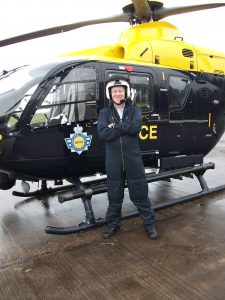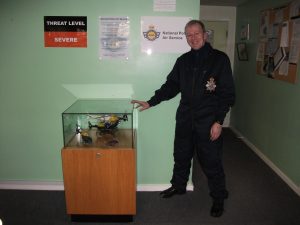Citizen Writes
Research hot topics
Researching flight safety at the UK National Police Air Service
2021-06-25
By Dr Simon Bennett

As Director of the Civil Safety and Security Unit at the School of Business, my research involves aviation safety and flight-deck human factors. Over 25 years I’ve worked with airlines including easyJet, DHL Air, Jet2, Monarch, British Airways World Cargo and GoFly. I have also worked with the police and the Royal Air Force’s Air Command.
I recently conducted a two-year research project working with the UK’s National Police Air Service (NPAS), researching human-factors and flight safety. The NPAS provides air-support to the forty-three police forces of England and Wales and to the British Transport Police. Typically, a NPAS EC135 helicopter carries a single pilot and two police officers, known as Tactical Flight Officers (TFOs). The TFOs are responsible for liaising with ground units and recording evidence on stills and video cameras.
The research used in-vivo observations of operational sorties and interviews with personnel to gain a better understanding of the risks associated with operating the NPAS fleet of EC135 helicopters.
During the project I observed eighteen sorties — a mixture of crime-fighting and intelligence-gathering missions — conducted interviews and attended flight crew team-training exercises. The interviews produced 30,000 words of testimony from pilots, TFOs, dispatchers and managers at bases across England and Wales. I found that operations are high-tempo, high-pressure and unpredictable. In this operational context, crews:
 develop a shared mental model of the task (for example, locating a gunman who has gone to ground) from multiple reports of varying quality submitted across busy communications channels in a noisy, vibrating and, in the Summer months, very hot cabin (noise, vibration and heat are stressors)
develop a shared mental model of the task (for example, locating a gunman who has gone to ground) from multiple reports of varying quality submitted across busy communications channels in a noisy, vibrating and, in the Summer months, very hot cabin (noise, vibration and heat are stressors)- lift (take-off) as rapidly as possible once a task has been accepted
- transit to the task location as quickly as possible by straight-lining
- negotiate controlled and uncontrolled airspace at close to maximum speed
- develop a shared mental model of hazards, including fuel-state, weather, terrain issues and airspace issues
- have the physical and psychological capacity to accommodate re-tasking. A crew might be re-tasked multiple times while airborne. Resetting missions is effortful
- monitor six police, and two air traffic channels while performing numerous other duties
- possess the technical and teamwork skills to rapidly develop robust work-arounds for in-flight technical problems, such as communications failures (the NPAS operates an ageing fleet)
- have the physical and psychological resilience to negotiate traumatic situations, such as murders, riots, being targeted with lasers and being shot at. During the 2011 English riots, shots were fired at the Birmingham police helicopter. The perpetrators were apprehended and sentenced to a total of 170 years. The EC135 is unarmoured. Pilots, TFOs and observers such as myself do not wear body armour
- have the physical and psychological resilience to work a four-days-on/four-days-off roster. One TFO observed of this roster: “One time in a twelve-hour shift, I did five hours and fifteen minutes flying. You might say ‘that’s not even half’. You are absolutely knackered after four hours. It is not like sitting on the flight deck at 35,000 feet on autopilot, monitoring.”

In my opinion, the most interesting finding concerned the way in which the teamwork protocol crew resource management (CRM), which is taught to all NPAS crewmembers, helped pilots and TFOs negotiate traumatic events.
In 2015, a NPAS EC135 crew witnessed a shockingly violent murder in Edmonton, North London, which also endangered the lives of a group of children. Bearing witness can induce acute stress disorder (ASD) and post-traumatic stress disorder (PTSD). The NPAS invited me to interview one of the TFOs involved in the incident. The TFO’s testimony suggested that adhering to CRM protocols helped crewmembers negotiate the shocking event by giving them a focus and a modus operandi. The CRM protocol helped crewmembers by introducing structure to a chaotic and traumatic situation. The Sergeant-TFO who witnessed the murder told me:
“We were all almost leaning on CRM as a kind of a support: ‘OK boys, you’ve got to remember what you are doing’. ‘Pilot, are you happy? Are you safe? Are you level? Are you with it? Are you OK?’ ‘Guy in the back …. How are you doing?’ The radios were dropping out. The mapping was inaccurate. So there was a lot of pressure. And we kind of almost took ourselves out of it by using that interaction … as a guide to get us through the situation …. There was a lot more chatter and interaction than there would have been without awareness of [CRM]”

While working with the NPAS, I formed the opinion that Britain’s policing authorities had created a highly proficient, dedicated and elite cadre of men and women without whom significantly fewer perpetrators would be apprehended.
At the project’s conclusion, I submitted a summary of my findings to the NPAS, then published them in two journal papers and a book chapter.
Details of the two journal papers can be found here.
Dr Simon Bennett
University of Leicester School of Business.
To hire Dr Bennett as a consultant through the University of Leicester please contact: sab22@le.ac.uk.